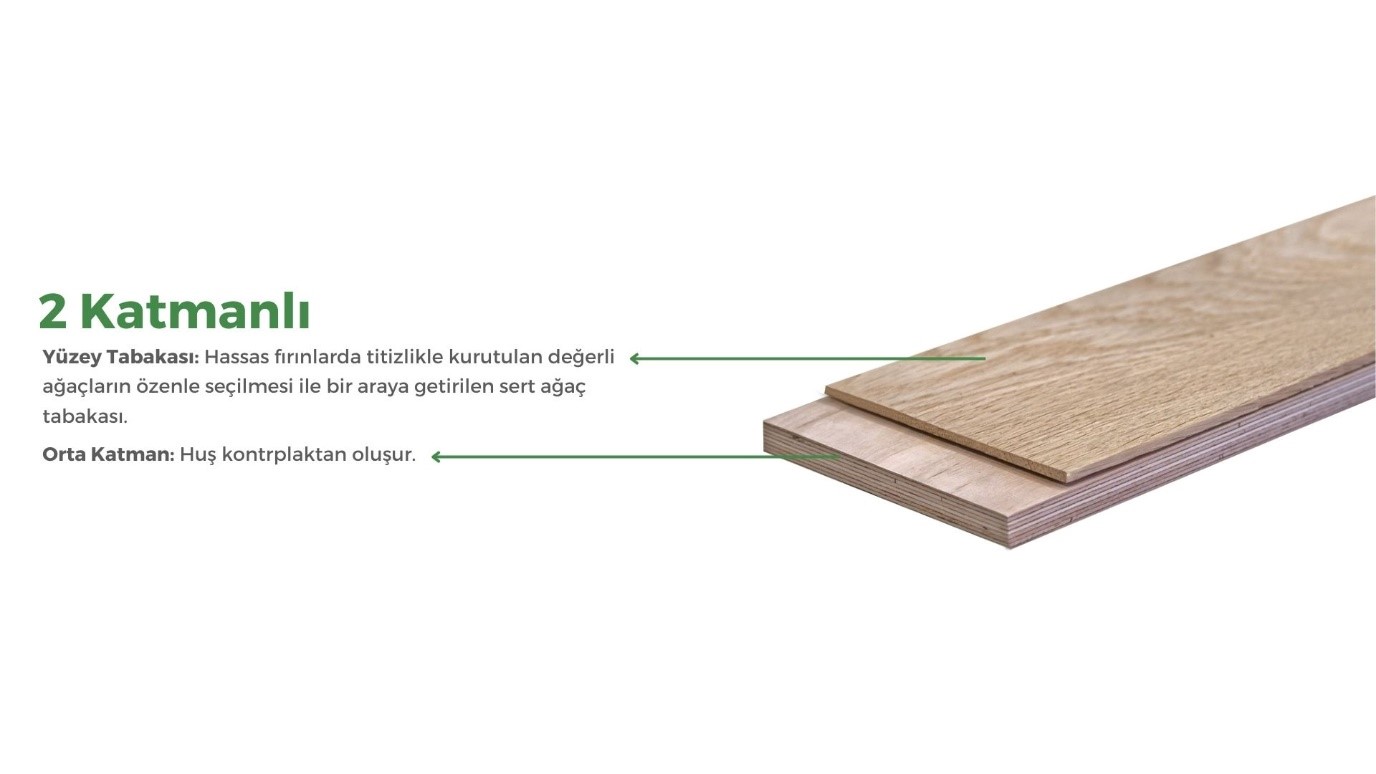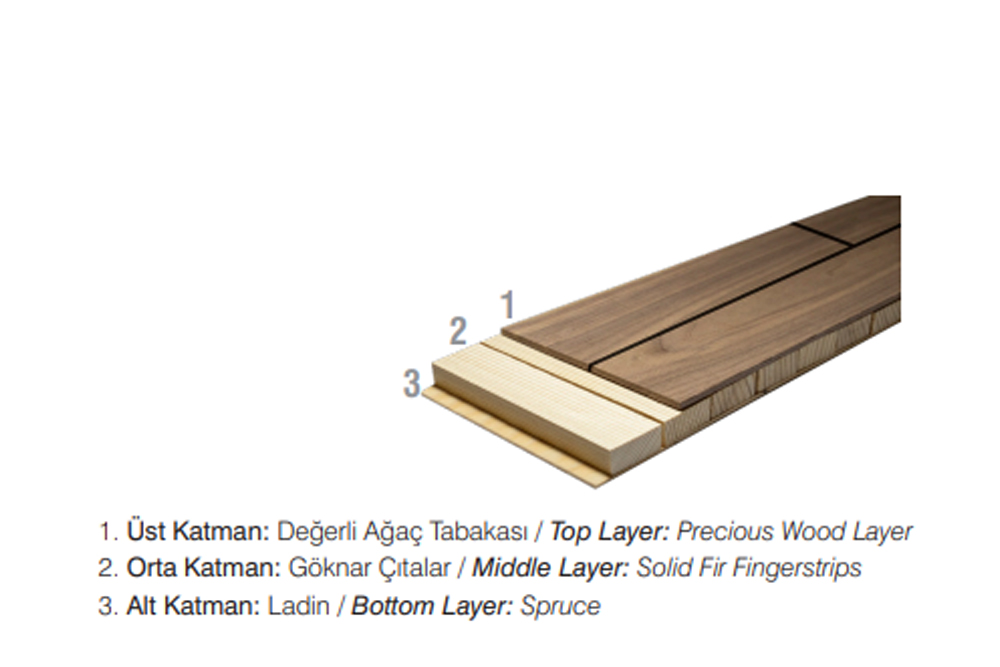

The first type of parquet we will discuss is solid wood parquet, which is
produced by using hard and durable wood, processed as a single piece at high
temperatures. Since there is no direct intervention in the material structure,
it preserves its natural qualities and appearance. The tongue-and-groove part
on the solid wood parquet, with a thickness ranging from 16 to 22 mm,
facilitates assembly during the installation phase. The application stages of
solid wood parquet include the primer applied to the floor, followed by parquet
installation, and then a sanding process called leveling after a certain
period, followed by optional polishing. Due to its natural properties, solid
wood parquet has a porous structure and is sensitive to moisture. The cost is
higher compared to other types of flooring due to being produced from a single
piece of wood and the challenges in the manufacturing process.

Laminate flooring panels are created by subjecting by-products of wood
and materials such as sawdust to high pressure with special adhesive materials.
The desired color and pattern are printed on paper, which is then impregnated
with resin on this panel. For scratch and impact resistance, it is covered with
a cellulose film layer. Underneath the flooring, there is a melamine coating
applied to protect against moisture. The click system makes the installation of
laminate flooring easy, using a floating system. Some products can also be
applied with an adhesive system. Laminate flooring is more cost-effective
compared to other types of parquet, does not require paint and polish, and has
high resistance to moisture. However, since it is not a natural material, it
lacks air permeability and may have disadvantages in terms of health.
Engineered wood
flooring is produced by subjecting two or three layers of wood material to high
heat and pressure compression. While a lower-quality type of wood or plywood is
used in the lower layers, the upper layer contains the main material of the
flooring, which is the wood itself. Due to the use of natural wood in the upper
layer, it has a similar porous structure to solid wood parquet and possesses
breathability.


Attention is paid to the moisture range of the floor to be installed, and the floor is covered with an underlayment. Then, the flooring is assembled by interlocking through the tongue-and-groove parts. Although this system is generally referred to as a floating system, engineered wood floorings applied with adhesive are also available. For example, engineered wood produced with two layers are more flexible compared to those with three layers, and therefore, they are recommended to be glued for use in areas with uneven surfaces. Engineered wood floorings offered with a polished finish do not require any correction or additional polishing during installation.
Potential
deformations due to moisture, given the engineered wood floorings' similar
porous structure to solid wood parquet, can be addressed through a leveling
process. Situations requiring repair can be resolved quickly and at a low cost.
Engineered wood floorings are more cost-effective compared to solid wood
parquet due to their ease of processing and production. On the other hand,
considering their natural structure, they present a healthier alternative
compared to laminate flooring.
Engineered wood flooring is one of the most commonly used materials for floor coverings. Its long-lasting use, durable structure, stylish and timeless appearance, as well as its natural qualities, contribute to the widespread preference for engineered wood. In the selection of engineered wood flooring, the thickness of the boards used is a crucial consideration.
The thickness of
the flooring is a quality that holds importance in terms of durability. Factors
such as the current condition of the floor, the presence of insulation, the
purpose of the space, and the frequency of use influence the choice of
different thicknesses for engineered wood flooring. When determining the
thickness of the flooring, not only the characteristics of the engineered wood
but also the areas where it will be used, the current state of the floor, and
insulation needs must be taken into account as primary criteria.

In engineered wood
flooring, a total thickness of 12-20 mm is considered acceptable, with the top
layer thickness being 3-6 mm. The thickness of the top layer directly affects
the quality of the product. Opting for thinner and cheaper engineered wood
flooring may result in poor quality and a short-lived user experience. This is
because engineered wood flooring with a thin top layer will wear away over
time, rendering it non-functional in the long run. The thicker the flooring,
the stronger the profile durability, providing higher impact resistance and
wear resistance. These features are crucial for protecting the floor against
daily use, heavy furniture, and areas with high foot traffic. Therefore, paying
attention to the thickness of the top layer of wood is critical when choosing
long-lasting engineered wood flooring.

In engineered wood
flooring, the top layer plays a crucial role in achieving an aesthetic
appearance. A thicker top layer allows for the creation of more intricate
patterns and effective wood textures on the floor. This enables the floor to
more effectively reflect the natural wood feel, contributing to a more
aesthetic look.

The thickness factor also has an impact on sound insulation. Thicker enginered wood flooring absorbs sounds from below, making the space quieter. Additionally, it reduces footstep noises, providing a comfortable user experience. On the other hand, if there are minor flaws in the subfloor, thicker wood covers and corrects them, offering a smooth surface appearance.
Ultimately, thickness is crucial in many aspects when choosing engineered wood flooring and is critical for long-term performance. Thicker engineered wood options may be more costly, but considering their lifespan and aesthetic advantages, especially in high-traffic areas like kitchens or living rooms, they will help you maintain a beautiful and durable floor for many years.
https://www.wordofmouthfloors.com/blogs/flooring/the-ultimate-guide-for-laminate-flooring
https://cesmimarlik.com/parke-cesitleri-nelerdir-laminant-parke-ve-lamine-parke-nedir/